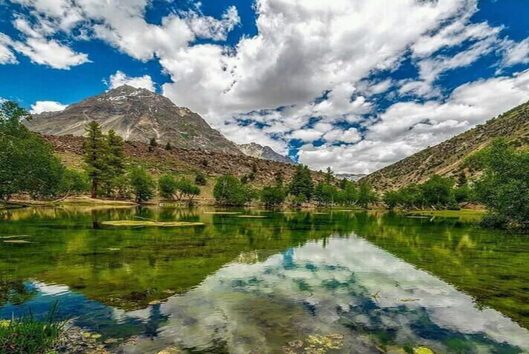Discover Hunza: Top 10 Must-Do Things In Hunza

Hunza, located in the Gilgit-Baltistan region of Pakistan, is known for its breathtaking landscapes, rich cultural heritage, and warm hospitality. Here are some things you can do when visiting Hunza:
1. Sightseeing of Nanga Parbat
2. Three Highest Mountain Range
3. Sightseeing of Rakaposhi
4. The Karakoram Highway
5. Baltit Fort
6. Try Traditional Dishes
7. Altit Fort
8. Boating in Attabad Lake
9. Witness Mesmerizing Passu Cones
10. Crossing Hussaini Bridge
11. Sightseeing of Worlds Highest Border
12. Sightseeing At Naltar Valley
13. Sightseeing at Blue Lake
14. Witness the Colorful Satrangi Lake
1. Sightseeing of Nanga Parbat
Nanga Parbat is a majestic mountain located in the Gilgit-Baltistan region of Pakistan. It is part of the Himalayan range and is known as the “Killer Mountain” due to its treacherous and challenging climbing routes. Sightseeing around Nanga Parbat offers breathtaking views of its towering peaks, glaciers, and surrounding natural beauty. Here are some key points of interest for sightseeing in the Nanga Parbat area:
- Gilgit City: Gilgit serves as a gateway to Nanga Parbat. While exploring the city, you can visit attractions such as the Gilgit River, Kargah Buddha, and lively local markets. It’s also a convenient place to make the necessary arrangements for your trip to Nanga Parbat.
- Fairy Meadows: Fairy Meadows is a picturesque alpine meadow located at the base of Nanga Parbat. It is a popular camping site and offers stunning panoramic views of the mountain. From here, you can witness the sunrise and sunset casting beautiful hues on the peaks.
- Raikot Bridge: Raikot Bridge is the starting point for the journey towards Fairy Meadows. The bridge provides a great vantage point to appreciate the grandeur of the surrounding landscape, including Nanga Parbat.
- Nanga Parbat Viewpoint: There are several viewpoints along the Karakoram Highway (KKH) that offer excellent vistas of Nanga Parbat. These viewpoints are strategically located and provide an opportunity to capture the beauty of the mountain from different angles.
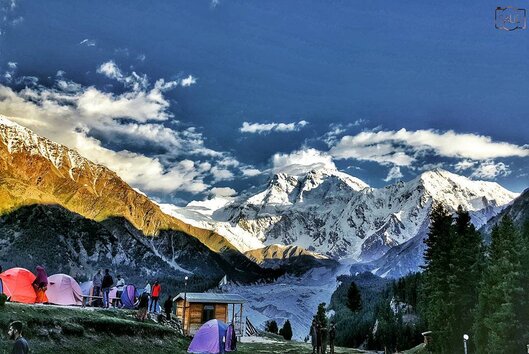
- Rupal Valley: Located on the southern side of Nanga Parbat, Rupal Valley is known for its scenic beauty and stunning views of the mountain’s Rupal Face, one of the highest rock faces in the world. It offers a unique perspective on the mountain’s grandeur.
- Nanga Parbat Base Camp: For adventurous and experienced climbers, reaching the base camp of Nanga Parbat is the ultimate goal. The base camp is located at an elevation of around 4,200 meters and offers an up-close experience of the mountain’s rugged beauty.
- Photography and Trekking: Nanga Parbat’s surroundings provide ample opportunities for photography enthusiasts. Whether you embark on a trek or choose to capture the landscapes from a distance, you’ll find stunning vistas that showcase the mountain’s raw and untouched beauty.
2. Three Highest Mountain Range
Hunza is a mountainous region located in northern Pakistan. It is known for its stunning landscapes and several majestic mountain ranges. Here are the three highest mountain ranges in Hunza:
- Karakoram Range: The Karakoram Range is one of the most iconic mountain ranges in the world and is located in the eastern part of Hunza. It is home to some of the highest peaks, including K2, the second-highest mountain in the world. K2, also known as Mount Godwin-Austen, stands at an elevation of 8,611 meters (28,251 feet) and is a significant attraction for mountaineers from around the globe. The Karakoram Range also includes other notable peaks such as Broad Peak, Gasherbrum I and II, and Masherbrum.
- Hindu Kush Range: The Hindu Kush Range is situated in the western part of Hunza and extends across several countries, including Pakistan, Afghanistan, and Tajikistan. It features numerous high peaks and offers breathtaking scenery. While the highest peaks of the Hindu Kush are located outside of Hunza, this mountain range has a significant influence on the region’s landscape and culture.
- Himalayas: Although the Himalayas do not extend directly into Hunza, their influence can be felt in the surrounding areas. The Himalayan Range is the highest mountain range in the world and spans several countries, including India, Nepal, Bhutan, and Tibet (China). While the highest peaks of the Himalayas are not within the immediate vicinity of Hunza, their grandeur and beauty are visible from various points in the region. These peaks include Mount Everest, the highest mountain on Earth, along with other renowned peaks like Kangchenjunga and Makalu.
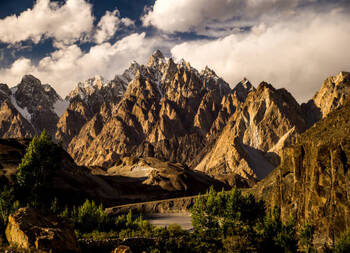
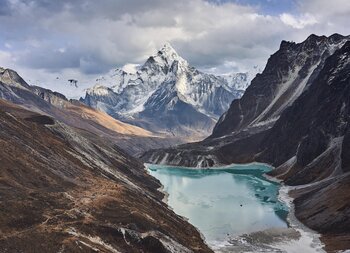
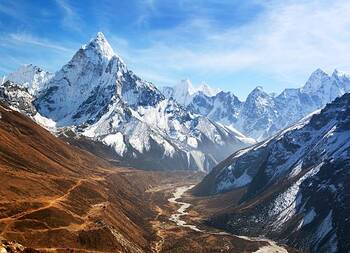
3. Sightseeing of Rakaposhi
Rakaposhi is a majestic mountain located in the Karakoram Range of Pakistan, near the Hunza Valley. It is one of the most prominent and visually striking peaks in the region, attracting visitors from around the world. Here are some of the best sightseeing opportunities and activities associated with Rakaposhi:
- Rakaposhi Viewpoint: To get a stunning panoramic view of Rakaposhi, head to the Rakaposhi Viewpoint. Located near the Karakoram Highway, this spot offers a clear vantage point to witness the towering beauty of the mountain. The viewpoint is accessible by road, and you can spend time marveling at the mountain’s grandeur while taking in the surrounding landscapes.
- Diran Base Camp: For more adventurous travelers, a trek to the Diran Base Camp is an excellent option. Diran Peak (7,266 meters) is located near Rakaposhi and offers a challenging yet rewarding trekking experience. The base camp provides an up-close view of both Rakaposhi and Diran, allowing you to admire their magnificence and take memorable photographs.

- Hunza Valley: Rakaposhi is situated in the Hunza Valley, which is renowned for its natural beauty and cultural heritage. Exploring the valley itself is a delightful experience, with lush green fields, terraced orchards, and traditional villages dotting the landscape. You can visit the ancient Altit and Baltit Forts, stroll through the picturesque Karimabad bazaar, and interact with the friendly locals who inhabit this scenic region.
- Hopper Valley: Hopper Valley is another picturesque spot near Rakaposhi that is worth visiting. It is known for its vibrant green meadows, blooming wildflowers, and crystal-clear streams. Hiking in Hopper Valley allows you to appreciate the stunning views of Rakaposhi from a different perspective, surrounded by nature’s tranquility.
- Photography and Relaxation: Rakaposhi offers an ideal backdrop for photography enthusiasts. Whether you’re a professional or an amateur, capturing the mountain’s changing moods, especially during sunrise and sunset, can result in breathtaking images. Additionally, you can simply find a serene spot, sit back, and relax while enjoying the serene ambiance and awe-inspiring views.
4. The Karakoram Highway
The Karakoram Highway (KKH) is a legendary and internationally renowned road that stretches across the Asian continent. It connects Pakistan and China, starting from the town of Hasan Abdal near Islamabad in Pakistan and ending in Kashgar, Xinjiang, China. Here’s some information about the Karakoram Highway:
- Scenic Beauty: The Karakoram Highway is often considered one of the most scenic and breathtaking roads in the world. It traverses through the majestic Karakoram mountain range, passing by towering peaks, deep valleys, glaciers, and glacial rivers. The journey offers mesmerizing views of snow-capped peaks, including Nanga Parbat, Rakaposhi, and the infamous K2.
- Engineering Marvel: The construction of the Karakoram Highway was a remarkable engineering feat. Completed in 1979, it is considered one of the highest paved international roads globally, with parts of it reaching an elevation of over 4,600 meters (15,000 feet) above sea level. The highway is built through challenging terrain, including steep slopes, rugged mountains, and unstable geological conditions.
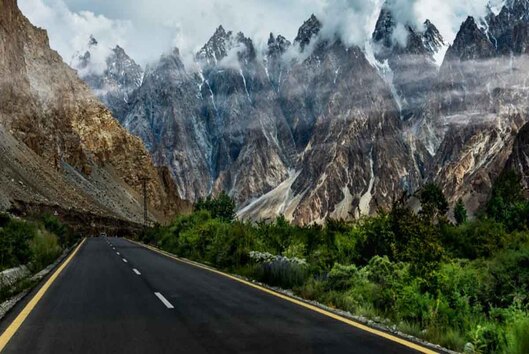
- Strategic Importance: The Karakoram Highway has significant strategic and economic importance. It serves as a major trade route between Pakistan and China, facilitating the movement of goods and fostering bilateral trade. The highway also plays a vital role in promoting tourism and cultural exchanges between the two countries.
- Cultural Diversity: The Karakoram Highway passes through various regions inhabited by diverse ethnic and cultural groups. Traveling along the highway provides an opportunity to experience the rich cultural heritage of the regions, including the Pakistani provinces of Gilgit-Baltistan and Khyber Pakhtunkhwa, as well as the Xinjiang region of China. Visitors can explore local traditions, taste regional cuisines, and interact with the hospitable people living in these areas.
- Adventure and Trekking: The Karakoram Highway is a gateway to numerous adventure activities and trekking opportunities. It provides access to some of the world’s highest mountains, including K2, and serves as a starting point for treks to base camps and high-altitude passes. Adventurous travelers can embark on thrilling hikes, and mountaineering expeditions, and explore the surrounding natural wonders.
- Cultural and Historical Sites: Along the Karakoram Highway, there are several cultural and historical sites worth visiting. These include the ancient Silk Route, Baltit Fort and Altit Fort in Hunza, Khunjerab Pass (the highest border crossing in the world), the stone carvings at Shatial, and the picturesque Attabad Lake formed by a natural landslide.
5. Baltit Fort
Baltit Fort is a historic fortress located in the town of Karimabad in the Hunza Valley of Gilgit-Baltistan, Pakistan. It is a UNESCO World Heritage Site and is known for its cultural and architectural significance. Here is some information about Baltit Fort:
- History: Baltit Fort has a rich history that dates back over 700 years. It was originally built in the 8th century as a defensive stronghold for the local Mirs (rulers) of Hunza. Over the centuries, the fort underwent several expansions and renovations under different rulers, including the royal family of Hunza. The present-day structure represents a blend of architectural styles influenced by Tibetan, Central Asian, and Islamic traditions.
- Architecture: The architecture of Baltit Fort is a fascinating mix of traditional and regional influences. The fort is built on a strategic elevated location, offering panoramic views of the surrounding valleys and mountains. It is made primarily of stone, wood, and mud mortar, with thick walls and intricately carved wooden balconies, windows, and doors. The fort’s design showcases the defensive and functional elements necessary for a fortification, combined with aesthetic elements that reflect the cultural heritage of the region.

- Restoration and Museum: Baltit Fort underwent extensive restoration in the 1990s, led by the Aga Khan Trust for Culture. The restoration project aimed to preserve the fort’s historical and cultural significance while making it accessible to visitors. Today, Baltit Fort serves as a museum that showcases the rich history, culture, and traditions of the Hunza Valley. The museum exhibits a collection of artifacts, photographs, traditional costumes, weapons, and other items that provide insights into the region’s past.
- Cultural Significance: Baltit Fort is not only a symbol of architectural beauty but also an important cultural landmark. It stands as a testament to the ancient heritage and traditions of the Hunza Valley. The fort represents the authority and power of the royal family of Hunza, and its restoration has helped revive and promote the local culture and craftsmanship. It serves as a venue for cultural events, festivals, and exhibitions, offering visitors an opportunity to engage with the vibrant local traditions.
- Views and Surroundings: One of the highlights of visiting Baltit Fort is the breathtaking views it offers. Perched on a hilltop, the fort overlooks the picturesque Hunza Valley, with its terraced fields, orchards, and snow-capped mountains. Visitors can enjoy panoramic vistas of the Karakoram Range, including the towering Rakaposhi peak. The surroundings of the fort also provide an excellent starting point for hikes, walks, and exploration of the local villages and landscapes.
6. Try Traditional Dishes
Hunza Valley is known for its unique cuisine, which combines local ingredients, flavors, and traditional cooking methods. Here are some traditional dishes you can try when visiting Hunza:
- Hunza Bread (Ghami/Ghamay): Hunza bread is a staple food in the region. It is a whole wheat bread that is baked in traditional tandoor ovens. The bread is thick, hearty, and has a slightly sweet taste. It is often served with butter, jam, or local cheese and is a delicious accompaniment to meals or can be enjoyed on its own.
- Hunza Apricot Soup (Gooli Soup): Made from locally grown apricots, this soup is a popular traditional dish in Hunza. The apricots are dried and then soaked to soften them before being cooked with water and spices. The result is a tangy and flavorful soup that is often enjoyed as a starter or as a refreshing beverage.

- Chapshuro: Chapshuro is a traditional meat-filled pastry that is popular in Hunza. It consists of a flaky dough filled with a mixture of minced meat (usually beef or mutton), onions, and spices. The filled dough is then baked or fried until golden and crispy. Chapshuro is a flavorful and satisfying snack that can be enjoyed throughout the day.
- Hunza Barley Soup: Barley soup is a nourishing and hearty dish commonly prepared in Hunza. It is made with locally grown barley, which is cooked with vegetables such as carrots, potatoes, and spinach, along with spices and seasonings. The soup is thick and comforting, providing warmth and sustenance, especially during the colder months.
- Harisa (Hunza Ghee): Harisa is a traditional dish made from wheat and meat, usually chicken or lamb. The wheat is soaked overnight, then simmered with the meat for several hours until it becomes a thick porridge-like consistency. The dish is traditionally cooked in Hunza ghee, which is clarified butter made from the milk of local goats. Harisa is often served during special occasions and is a symbol of hospitality in the region.
- Apricot Tart: As apricots are abundant in the Hunza Valley, apricot-based desserts are quite popular. Apricot tarts are a sweet treat made with a buttery crust filled with fresh apricots and a sweet syrup made from apricot pulp. The tart is baked until golden and served as a delightful dessert, showcasing the natural sweetness of the local apricots.
7. Altit Fort
Altit Fort is a historic fort located in the village of Altit, near Karimabad in the Hunza Valley of Gilgit-Baltistan, Pakistan. It is one of the oldest forts in the region and holds great historical and cultural significance. Here’s some information about Altit Fort:
- History: Altit Fort has a history that spans over 800 years. It was originally built in the 11th century by the Mirs (rulers) of Hunza as a defensive structure and the residence of the ruling family. Over the centuries, the fort underwent expansions and renovations under different rulers, reflecting the changing architectural styles and cultural influences of the region.
- Architecture: The architecture of Altit Fort is a fine example of ancient craftsmanship and engineering. The fort is built on a strategic hilltop, offering commanding views of the Hunza Valley and surrounding mountains. It is constructed using stone, mud, and timber, with thick walls and intricate wooden carvings. The fort’s design showcases a blend of Tibetan, Central Asian, and Islamic architectural elements.

- Restoration and Museum: Altit Fort underwent extensive restoration in the 1990s, with support from the Aga Khan Trust for Culture. The restoration project aimed to preserve the fort’s historical and cultural heritage while making it accessible to visitors. Today, the fort houses a museum that displays artifacts, photographs, and exhibits that provide insights into the region’s history, culture, and way of life. The museum helps visitors understand the rich heritage of the Hunza Valley.
- Cultural Significance: Altit Fort holds significant cultural importance in the Hunza Valley. It was the seat of power for the Mirs of Hunza and served as the center of political, social, and economic activities in the region. The fort also played a vital role in defending the valley from external invasions. Visiting Altit Fort allows you to delve into the history and cultural traditions of the local community.
- Views and Surroundings: Altit Fort offers panoramic views of the surrounding landscapes, including the Hunza Valley, Karakoram Range, and the flowing Hunza River. The fort’s elevated location provides a serene and picturesque atmosphere, making it an ideal spot for photography and enjoying the stunning natural beauty of the area.
- Traditional Performances: At Altit Fort, you may have the opportunity to witness traditional cultural performances. Local musicians and artists often perform traditional music, dance, and theater, showcasing the vibrant cultural heritage of the region. These performances add an extra layer of authenticity and entertainment to your visit.
8. Boating in Attabad Lake
Boating in Attabad Lake offers a captivating experience amidst the breathtaking landscapes of the Hunza Valley in Gilgit-Baltistan, Pakistan. This stunning lake was formed as a result of a natural landslide in 2010 and has quickly become a popular tourist attraction. As you embark on a boat ride across the crystal-clear turquoise waters, you can marvel at the surrounding majestic mountains, including the towering Karakoram Range. The tranquility of the lake and the serenity of the surroundings create a serene atmosphere, allowing you to immerse yourself in the beauty of nature. Whether it’s a peaceful glide on a traditional wooden boat or an adventurous kayaking expedition, boating in Attabad Lake offers a wonderful opportunity to connect with the pristine surroundings and create lasting memories of this remarkable destination.
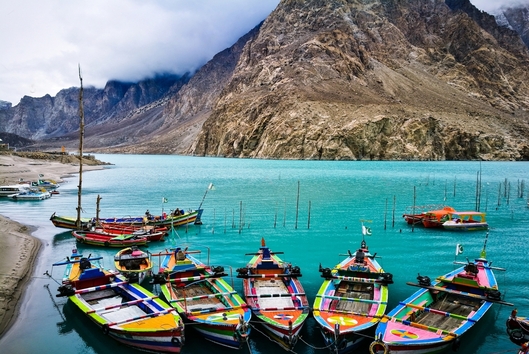
9. Witness Mesmerizing Passu Cones
Passu Cones, also known as Passu Cathedral or Passu Peaks, is a majestic and iconic mountain formation located in the Upper Hunza region of Gilgit-Baltistan, Pakistan. These awe-inspiring peaks are part of the Karakoram Range and captivate visitors with their sheer beauty and grandeur. The Passu Cones are characterized by their distinct pyramid-like shapes and towering presence, reaching heights of over 6,000 meters (19,685 feet). The snow-capped peaks stand proudly against the backdrop of the surrounding glaciers and valleys, creating a picturesque and breathtaking sight. The Passu Cones are not only a treat for the eyes of mountaineers and nature enthusiasts but also a source of inspiration and wonder for all who witness their magnificence.

10. Crossing Hussaini Bridge
Crossing Hussaini Bridge in the Hunza Valley is a thrilling adventure. The suspension bridge, known as the Indiana Jones Bridge, hangs precariously over the Hunza River. With missing planks and a slight sway, it tests your nerves. Gripping the steel cables, you carefully navigate the gaps, all while surrounded by breathtaking views of mountains and valleys. The rushing river below adds to the adrenaline rush. Crossing the bridge is a unique and memorable experience that embraces the spirit of adventure. It leaves you with a sense of accomplishment and a lasting memory of the awe-inspiring beauty of the Hunza Valley.
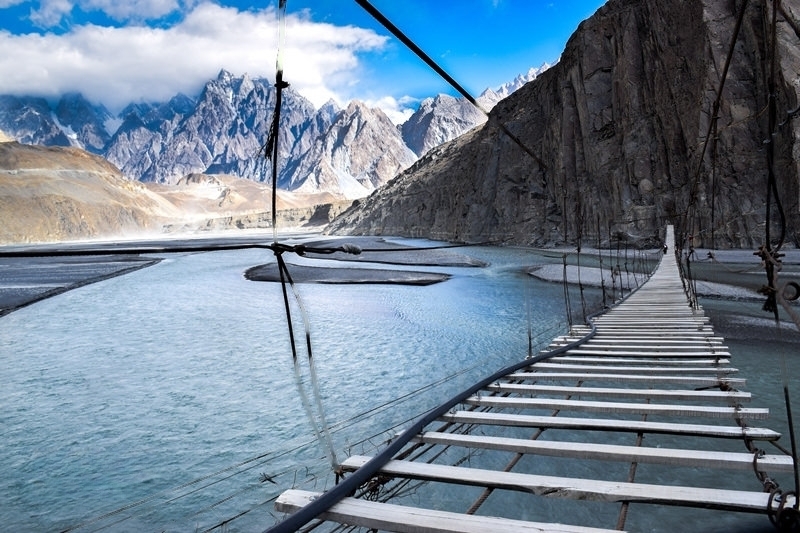
11. Sightseeing of Worlds Highest Border
The world’s highest border is located in Gilgit-Baltistan, Pakistan, where the Karakoram Range forms the boundary between Pakistan and China. Visiting this border offers breathtaking views of towering peaks, including K2. The Khunjerab Pass, at 4,693 meters (15,397 feet), is the highest paved international border crossing. You can witness border posts, checkpoints, and interactions between Pakistani and Chinese authorities. The area is rich in biodiversity, with wildlife like Marco Polo sheep. The border visit combines natural beauty, geopolitical significance, and cultural experiences, showcasing the grandeur and complexities of this unique location.
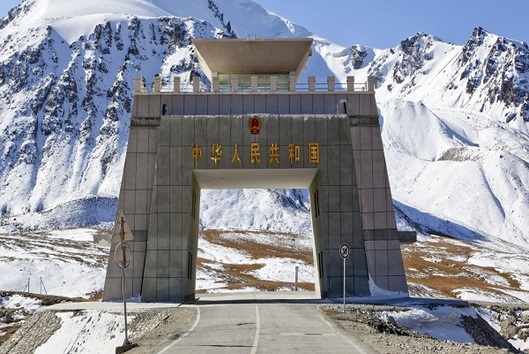
12. Sightseeing At Naltar Valley
Naltar Valley is a scenic and picturesque destination located in Gilgit-Baltistan, Pakistan. Sightseeing in Naltar Valley offers a range of attractions and natural beauty to explore. Here’s a glimpse of what you can expect:
- Stunning Lakes: Naltar Valley is famous for its pristine lakes with crystal-clear turquoise waters. The most notable ones include Naltar Lakes, Satrangi Lake, and Blue Lake. These lakes are surrounded by majestic mountains, and lush greenery, and offer a peaceful and serene ambiance.
- Skiing and Snowboarding: Naltar Valley is a popular destination for winter sports enthusiasts. The valley boasts well-groomed ski slopes, making it an ideal place for skiing and snowboarding activities. Ski competitions and festivals are also organized during the winter season, attracting both locals and tourists.
- Colorful Meadows: During the summer months, Naltar Valley comes alive with vibrant meadows adorned with a carpet of wildflowers. The meadows offer a picturesque setting for leisurely walks, picnics, and photography, allowing visitors to immerse themselves in the natural beauty of the valley.
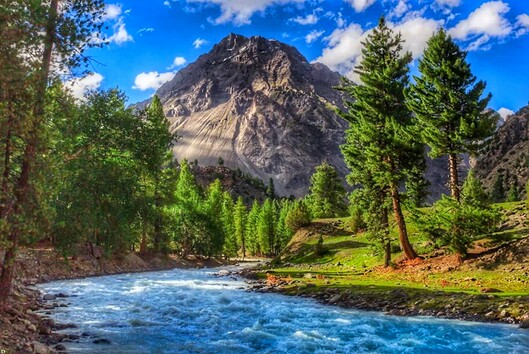
- Forests and Wildlife: Naltar Valley is home to dense forests of pine, cedar, and birch trees. Exploring these forests provides an opportunity to witness diverse flora and fauna, including a variety of bird species and rare wildlife such as the snow leopard.
- Naltar Wildlife Sanctuary: Located in the valley, the Naltar Wildlife Sanctuary is a protected area that aims to preserve natural habitats and wildlife. Visitors can take guided tours or hikes within the sanctuary to observe and appreciate the region’s biodiversity.
- Nomadic Culture: Naltar Valley is also known for its nomadic communities, such as the Gujjar and Bakarwal tribes. Interacting with the locals gives visitors a chance to learn about their traditional way of life, culture, and hospitality.
13. Sightseeing at Blue Lake
Blue Lake, located in the Naltar Valley of Gilgit-Baltistan, Pakistan, is a captivating sightseeing destination known for its pristine beauty. Here’s what you can expect when visiting Blue Lake:
- Azure Waters: True to its name, Blue Lake boasts stunning azure-colored waters that mesmerize visitors. The lake’s vibrant blue hue is a result of the surrounding glaciers and the minerals suspended in the water, creating a picturesque and serene atmosphere.
- Majestic Mountains: Blue Lake is surrounded by majestic snow-capped mountains, offering a breathtaking backdrop to the tranquil waters. The towering peaks provide a stunning contrast against the vibrant blue of the lake, creating a scene of natural beauty that is a feast for the eyes.
- Scenic Hiking Trails: Exploring Blue Lake allows you to embark on scenic hiking trails that wind through the picturesque landscape. The trails offer panoramic views of the surrounding mountains, lush green meadows, and the shimmering lake, providing ample opportunities for nature enthusiasts and photographers.
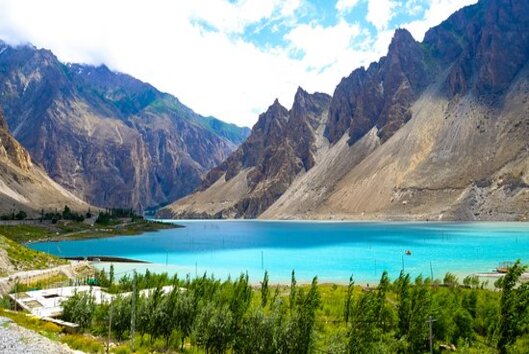
- Peaceful Ambiance: Blue Lake offers a peaceful and serene ambiance, away from the hustle and bustle of city life. The tranquility of the surroundings allows visitors to relax, unwind, and immerse themselves in the beauty of nature.
- Picnic Spot: The shores of Blue Lake provide an ideal spot for picnics and leisurely activities. Visitors can bring their own food, spread out a picnic blanket, and enjoy the enchanting views while savoring a meal amidst the natural beauty.
- Photography Opportunities: Blue Lake presents fantastic photography opportunities with its breathtaking colors and stunning landscape. Capture the vibrant blue waters, reflections of the mountains, and the interplay of light and shadows to create memorable images.
14. Witness the Colorful Satrangi Lake
Satrangi Lake, nestled in the picturesque Naltar Valley of Gilgit-Baltistan, Pakistan, is a breathtaking sight. Its name, meaning “Seven Color Lake,” perfectly describes its enchanting beauty. The lake mesmerizes visitors with its vibrant hues, ranging from blues and greens to purples. This natural wonder is created by the reflection of the surrounding mountains and the presence of minerals in the water. The serene surroundings and scenic backdrop of snow-capped peaks make Satrangi Lake a tranquil and photogenic paradise. Witnessing the captivating colors of Satrangi Lake is a magical experience that will leave you in awe of nature’s artistry.
